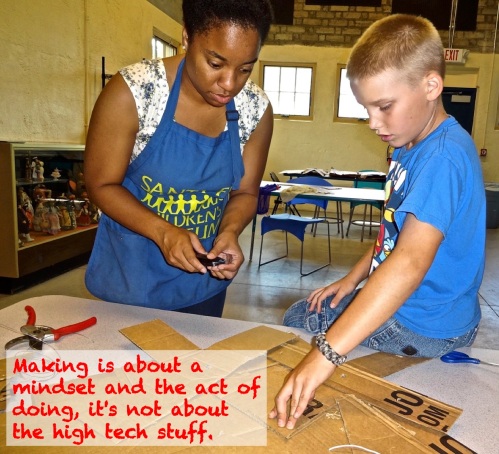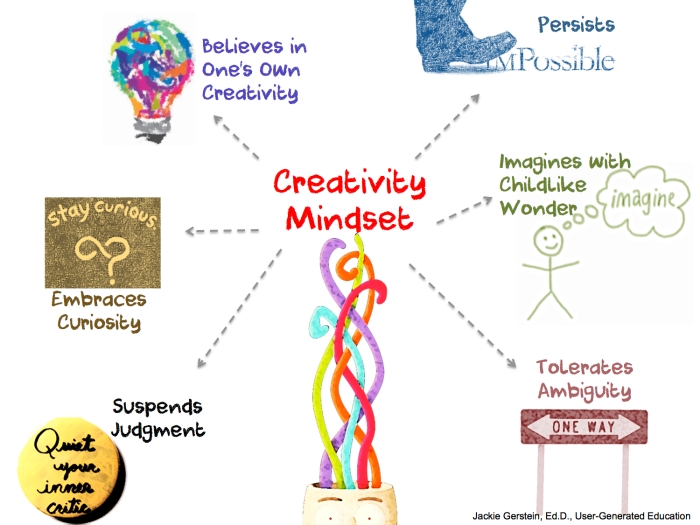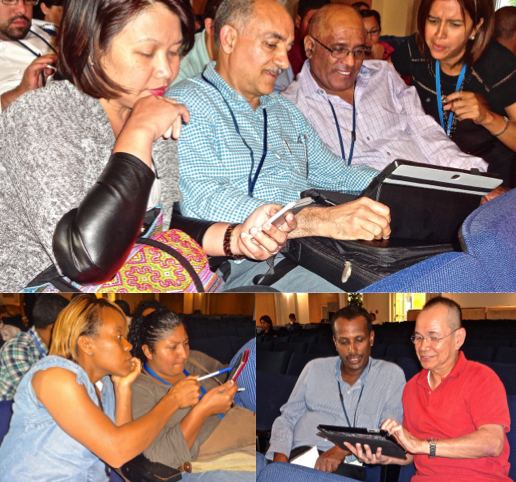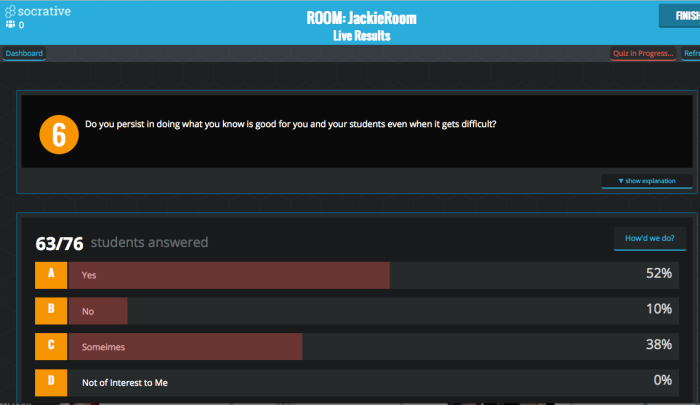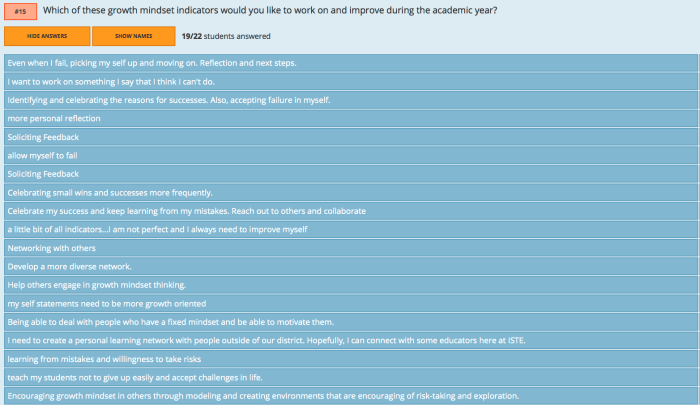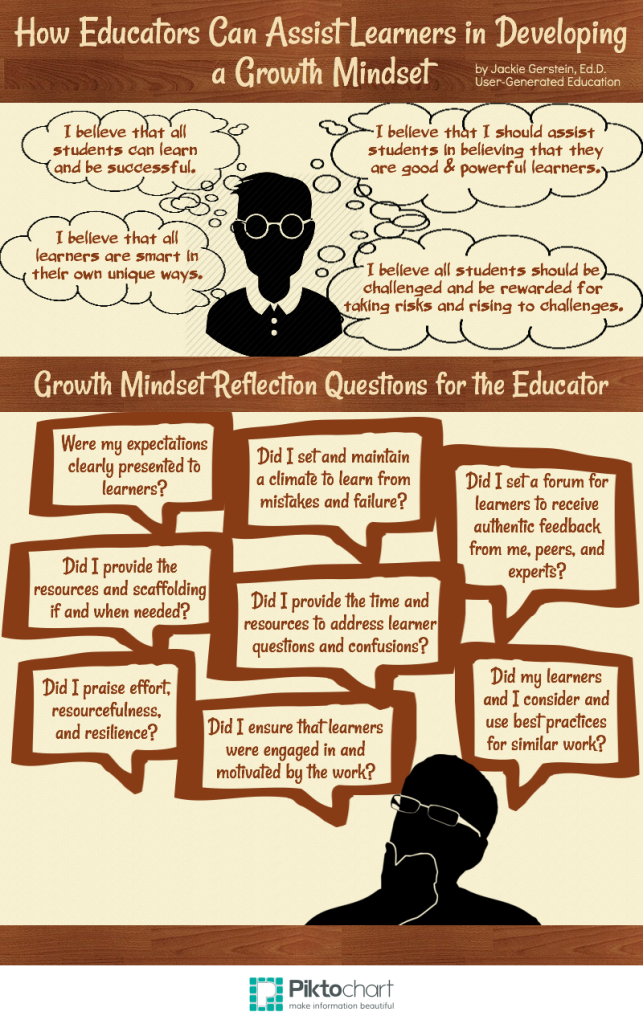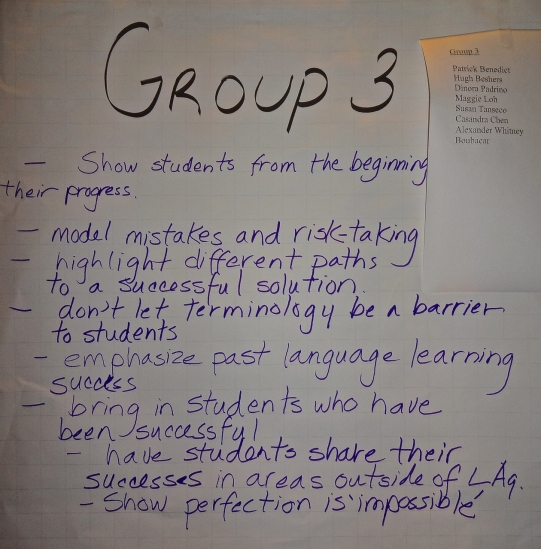Posts Tagged ‘mindset’
Making MAKEing More Inclusive
Update/Addendum: Last evening I traveled to Albuquerque with a friend to see the makerspace there and attend their monthly meeting. It is a very well-appointed makerspace and there was good attendance for the meeting. I discussed with my friend on the drive back home my concern with the homogeneous demographic make-up of those in attendance. They were mostly white men and women who seemed to have a comfortable income. I stated that given that this makerspace is fairly well established with a five year history, the folks running the space should now be more proactive in increasing the diversity of their membership and becoming more inclusive. My friend took issue with my comment, saying that this is not their purpose. She basically said that the makerspace is what it is, that becoming more inclusive is not their purpose, and that they doing fine with those who they are currently serving. I talked about initiatives like Black Girls Code which does outreach for the goal of providing skills to a population who might not gain these skills without this type of outreach. She saw no reason for this makerspace to change their status quo. We ended up agreeing to disagree but I did get motivated to revisit and update this post . . .
The maker movement and maker education, in my perspective, are such great initiatives – really in line with what student-centric education should be in this era of formal and informal learning.
Maker education (often referred to as “Maker Ed”) is a new school of educational thought [at least in terms of having an “official” educational label – JG] that focuses on delivering constructivist, project-based learning curriculum and instructional units to students. Maker education spaces can be as large as full high school workshops with high-tech tools, or as small and low-tech as one corner of an elementary classroom. A makerspace isn’t just about the tools and equipment, but the sort of learning experience the space provides to students who are making projects. (9 Maker Projects for Beginner Maker Ed Teachers)
Social media has helped me see more of the big picture and become aware of some of the problems associated with the maker movement. The two I discuss in this post are:
- Maker movement initiatives are often driven by more affluent white males.
- The maker movement is too often being associated with the tech stuff – 3D Printers, Arduinos, littleBits, Makey-Makeys – stuff that less affluent schools and community programs can afford.
Maker movement initiatives are often driven by affluent white males.
When the language, culture, and tools of the current makerspaces, maker faires, MAKE publications are examined, they tend to be less inclusive of females, older adults, and people of color.
Spaces and ‘Maker’ activities are promoted as being inclusive, open spaces. However, this type of rhetoric tends to ignore social inequalities that impede access and participation, where privilege, oppression, and domination over some groups of people are not acknowledged (Dunbar-Hester, 2014). If technical tinkering, STEM, and digital fabrication are the economic forces that will empower Makers, and women and people of color are not participating in these activities in a visible way, that power will remain unequally distributed. It is possible that the maker movement will have a transformative effect and create opportunity for upward mobility but we must acknowledge the fact that the idea of “making” is a privileged idea. (Power, Access, Status: The Discourse of Race, Gender, and Class in the Maker Movement)
The Maker movement has grown large enough and influential enough that it’s time to turn a critical eye to the culture of the community, what we want it to be and what it really is,” declared Dr. Buechley. The most striking statistics Buechley shared focused on the race and gender of the Makers on its covers. Of the 40 people featured, she found that 85% have been men and boys–and none were people of color. The current editorial staff has a similar ratio–87% men, and also no people of color. “Are you serious!? MAKE, you can do better. It’s your responsibility to do better,” Buechley exclaimed. (Watch Dr. Buechley’s talk at https://vimeo.com/110616469) The notion that one does not need to talk about gender, race, sexual orientation, class, etc. because what matters is how well you can hack largely disregards privileges that people have in society and constitutes part of the explanation for why there are so few women, queers, and people of color in hackerspaces. But women aren’t the only ones who have felt marginalized and isolated at mainstream hackerspaces. Many men have also found the culture exclusionary or aggressive and are also also seeking safer spaces. (Is the Maker Movement About Hacking Society—Or Just Hardware?)
Here are some additional quotes, articles that discuss the need for a maker environment more inclusive of gender and people of color.
I know that the Maker Movement is working to be more inclusive and I challenge its leadership to do even more to include every kid in every community in its programming. I challenge each of us to support not just our own daughters and sons in Making but the girls and boys in all communities. (Welcoming All Girls in the Maker Movement: Let’s Make it Happen)
Maker and hackerspaces are meant to be places to build, tinker, and fix things, but that process won’t flourish without a friendly, inclusive environment. (Is the Maker Movement About Hacking Society—Or Just Hardware?)
The idea of inclusion is not only important for community organizations or schools serving underserved populations. Every makerspace should be aware of their capacity to serve all people: children and adults, all genders, all backgrounds, and those who are interested in the arts, engineering, or both. Even in the best-resourced maker environments, there should be constant vigilance about the assumptions that are made about the people who might want to use them. (Making for All: How to Build an Inclusive Makerspace)
The maker movement is too often being associated with the tech stuff – stuff that less affluent schools and community programs cannot afford.
Changing Perceptions About the Stuff
3d Printers, Ardinos, litteBits, Makey-Makeys, GoSpheros, Lillipads, . . . oh my! These technologies are seductive especially seeing all the press they get on social media, blogs, and Kickstarter. Given all of the media coverage, an educator new to Maker Education may get the perception that it is all about this kind of high tech stuff. For less affluent schools or after-school programs, it may seem that maker education is out of their reach given budgetary restraints. A maker education program can be fully implemented with minimal cost supplies. Cardboard boxes, recycled materials such as water bottles, detergent bottles, and other plastic throwaways, tape, glue guns, scissors/knives, and markers in conjunction with learners’ imaginations, creativity, and innovative ideas can be the stuff that makerspaces are made of. 
In addition, there are lots of making resources that are inexpensive. Here is an image of the circuit kit I prepared for my week long maker camp for over a dozen kids. It cost less than $100 with careful shopping via ebay and the local dollar store. It contains LEDs, batteries, alligator clips, copper tape, magnets, paper clips, and electrical tape. It served these dozen+ kids for five half days of making.
Changing Perceptions about What Activities Are Considered Making
In addition, to using cheaper materials, we need to expand our perceptions about what constitutes maker activities.
In an analysis of every MAKE magazine cover since the first issue in 2005–36 in all–Buechley found that the photos portrayed a “very narrow definition” of Maker activities. The themes have skewed heavily towards electronics, which have been featured on 53% of covers, followed by vehicles (31%), robots (22%), rockets (8%), and music (5%). What’s missing, she said, are examples from the world of ceramics, costume-engineering, and weaving. She pleaded with the audience to reach out to a more diverse group of makers and include all types of kids. “You gotta do more than robots,” she said. (MAKE’ing More Diverse Makers)
Changing Perceptions: Making Is About a Mindset and a Process Not About the Stuff
Finally, in the same vein as it’s about the pedagogy, not about the technology; making is about a mindset and the act of doing, it’s not about the high tech stuff. As I discussed in The Intersection of Growth Mindsets and Maker Education:
A maker mindset involves having a can-do attitude and a growth mindset – a belief that your capabilities can be developed, improved and expanded. It’s not just a matter of what you know, it’s a matter of taking risks and perhaps failing and learning from those failures. It’s a matter of being open to exploring new possibilities and developing your full potential. (The Intersection of Growth Mindsets and Maker Education)
If making, the maker movement, maker education is viewed as a mindset, as a process, as a way to be creative and innovative; then the types and kinds of materials don’t matter. What matters, first and foremost, is the act of making.
The Mindset of the Maker Educator: K12 Online Conference Presentation+Slides
Here is my presentation, The Mindset of the Maker Educator, that I recorded for the K12 Online Conference:
Slidedeck for The Mindset of the Maker Educator:
Here is a direct link to my K12 Online Conference Presentation: http://k12onlineconference.org/?p=2934
The Educator and the Growth Mindset
I am facilitating an in-service on Growth Mindsets for Educators. I created an infographic, Thinglink, and Slide Presentation of resources that I am sharing below:
 Thinglink that contains links to Growth Mindset Resources http://www.thinglink.com/scene/549674394805338114
Thinglink that contains links to Growth Mindset Resources http://www.thinglink.com/scene/549674394805338114
Google Presentation


